NSW
TIN PROJECTS
Ownership
Tenure
EL8902 – Glen Innes, EL8903 – Emmaville.
Granted until 21st October, 2023
EL8913 – Tingha. Granted until 8th November, 2023
Total – 512 square kilometres
EL 9347 – Tin Hill granted until 27th January 2022
530 square kilometres
Target
Bulk mineable vein or breccia style tin-tungsten.
Geology
The Emmaville-Torrington and Tingha districts host the New England’s significant tin deposits, including Taronga Tin deposit which contains a JORC 2012 Indicated and Inferred Mineral Resource estimate of 36.3Mt at 0.16% Sn for 57,200 tonnes of contained tin (Source: AusTin Mining Limited).
Tin deposits in the New England occur as sheeted vein style (Taronga); disseminated greisen (Glen Eden); breccia pipe (Glen Eden) and skarn/carbonate replacement associated with Late Permian to Early Triassic highly fractionated leucocratic granitoid intrusions.
Historic Production and Exploration
EL8902 contains the Glen Eden, Deepwater, Bald Nob and Herriots Reef tin prospects. Glen Eden is the most advanced prospect having had soil sampling and some drilling. It contains Sn-W mineralisation in a massive and stockwork greisen and breccia pipe.
EL 8903 covers the highly mineralised Mole Granite, which hosts the Targona tin deposit. The cassiterite mineralisation associated with the Mole Granite has been the source for the extensive and rich Tertiary deep lead and Quaternary placer deposits of cassiterite in the Emmaville area.
There is patchy coverage of historic titles over EL 8903 with few surface geochemistry samples and no drilling data available.
EL8913 covers the mineralised Upper Permian, I-type, Gilgai Leucogranite, which contains a large number of disseminated and vein-type, cassiterite and polymetallic sulfide occurrences with diverse metal associations (Sn, Pb, Zn, Cu, Ag, As, Mo). Weathering of tin greisen systems hosted in the Gilgai Granite and Elsmore Granite has also produced rich tin placer deposits in deep lead and colluvial sediments beneath and surrounding basalt flows in the Tingha-Stannifer, Elsmore and Newstead areas. Tin production from the alluvial sources in the late 1800s to early 1900s exceeded 70,000 tonnes of concentrate. There has been very little exploration within the tenement and shallow drilling targeted diamonds with no base metal assays.
TinOne Resources Inc. Exploration
Exploration Plans
TinOne Resources Inc. plans to execute systematic exploration utilising modern techniques to define drill targets. This is likely to include:
- Continued capture of historic data
- Surface mapping, rock sampling and potentially ultra-low detection-limit soil sampling of to define mineralised corridors
- If targets warrant, gradient array IP/resistivity and potentially pole-dipole IP/resistivity
- If targets warrant, reverse circulation and/or diamond drilling of integrated targets.

